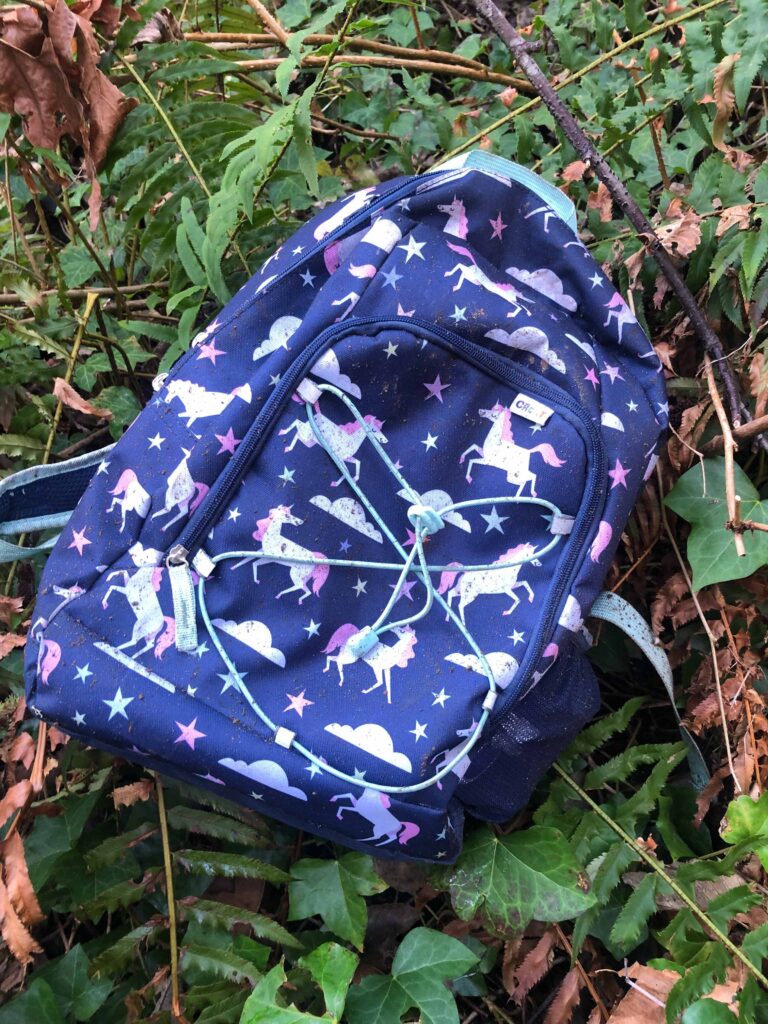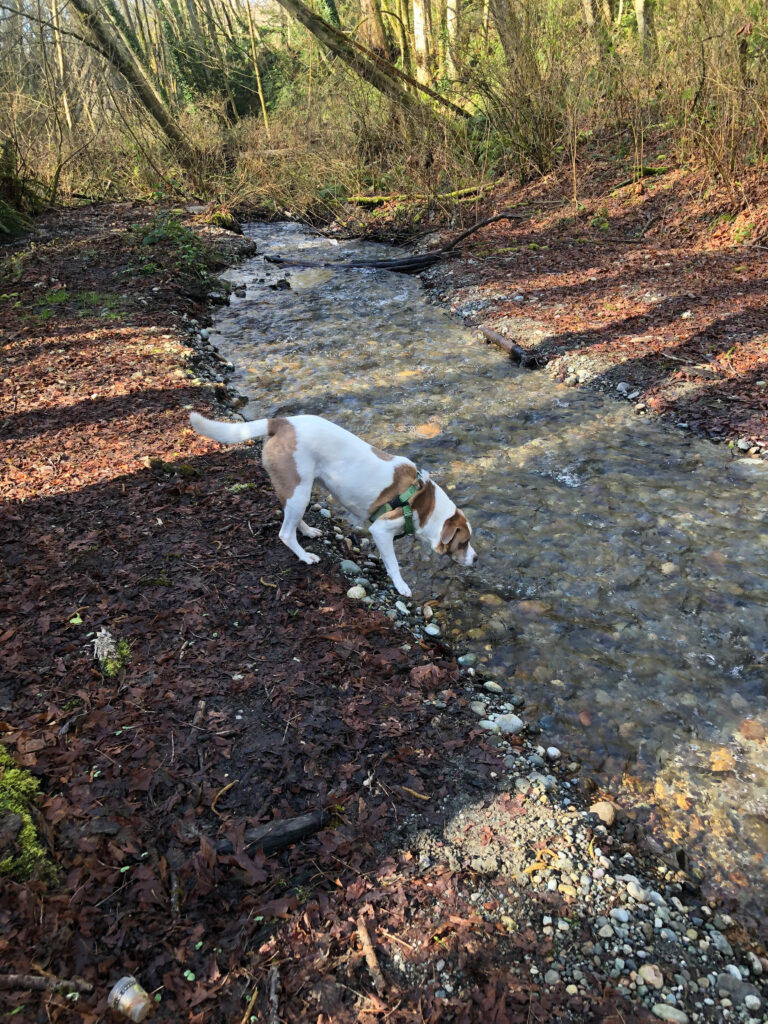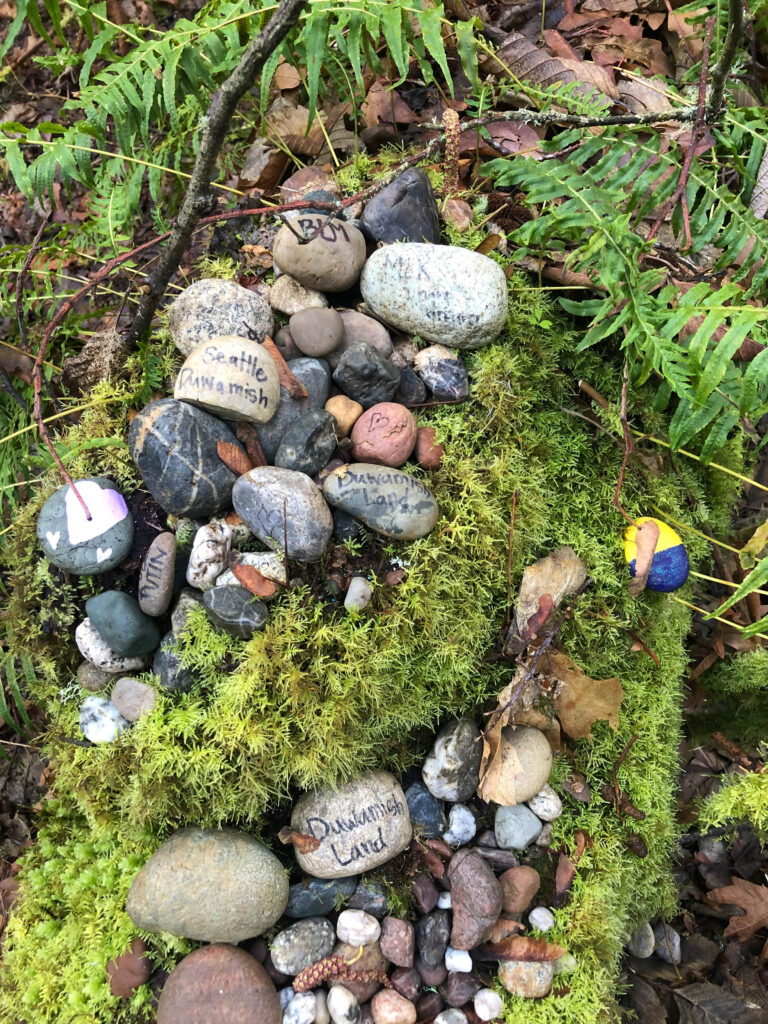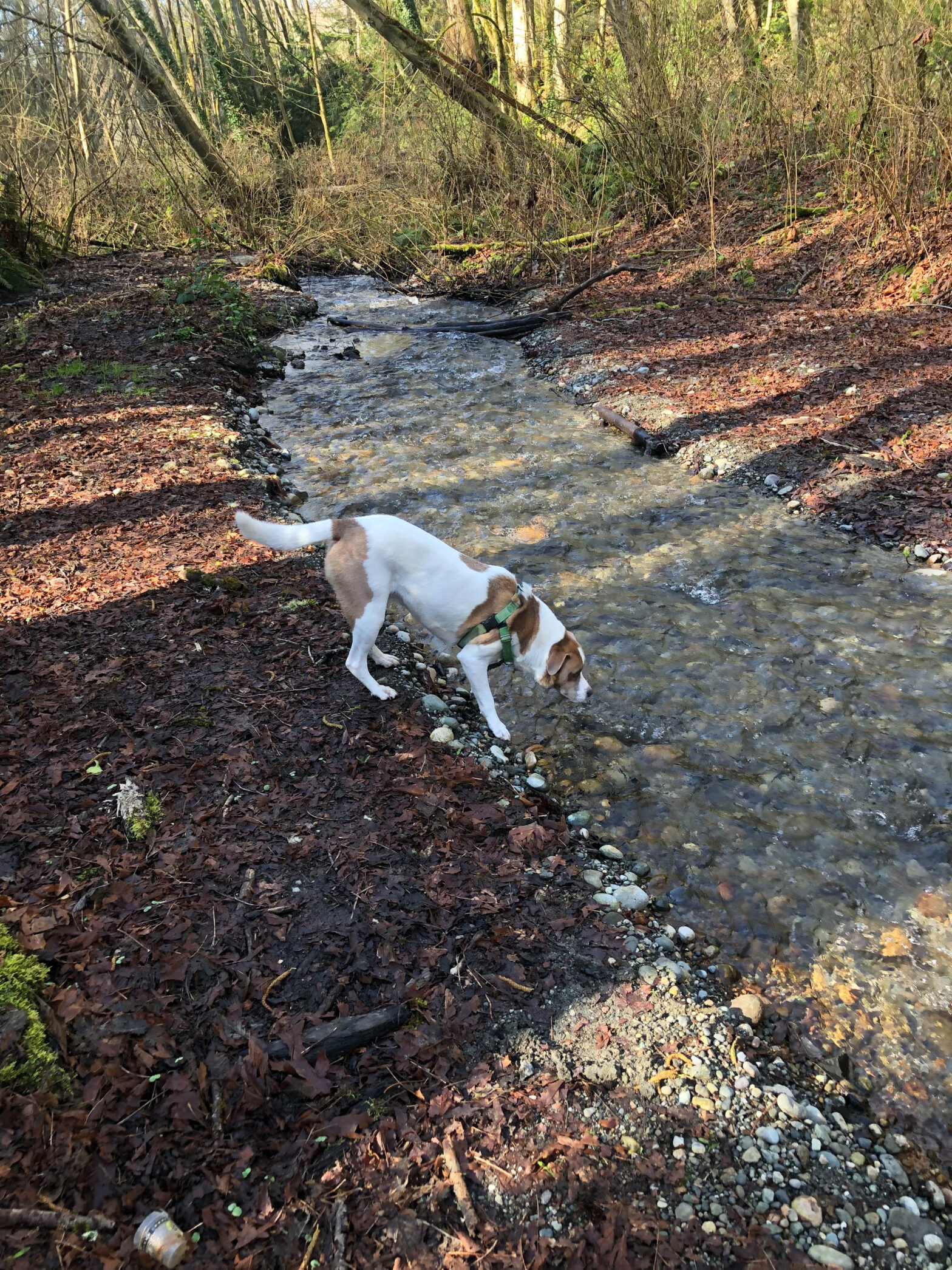In this second of three posts exploring our life’s purpose, I discuss the importance of viewing our goals from a fresh perspective. Are you ready, able, and willing to critically examine your current mindset and feelings about change in order to achieve better results? If so, join us on a pictorial ramble through Salmon Creek Ravine in Burien.

Ramble 27
Last Wednesday, Ajax and I drove to Burien on an errand and took a detour to explore Salmon Creek Ravine. On the third try, we happened upon a wooden sign near Seahurst Park, a park we visited earlier this year. Right beside it is a trail leading down to sloping hillsides of ferns and birdsong. This path looked promising.
For the next hour or so, we explored the trail twisting through old-growth cedars, madrone, Douglas firs, large maples, and alders. Mid-morning in March on a weekday is a fabulous time to visit if you want the place to yourself. We only saw one other person. And one abandoned backpack.
As we walked, I reflected on a goal I recently developed during a Precision Nutrition course: to change my fixed mindset into a growth mindset. But how, exactly, was I going to do that? What if I tried an approach similar to the one I use with my clients?

Start with the End Goal in Mind
To embark on any physical journey, such as climbing Mt. Rainier or hiking Rim-to-rim-to-rim in the Grand Canyon, you start with the end goal and work backward to the present day. I am well acquainted with programming for physical objectives. After all, I’ve been doing it for twenty-five years.
Alpine Tasks
In the mountains, we face any number of challenges such as navigating slopes while carrying a heavy pack. Dealing with the weather. Paddling for hours with extended legs. Preparing meals. Building shelters, igloos, or wind walls. Sleeping on uneven, hard ground. Looking upward while a partner climbs. The list is long. And each item provides a different stress on the mind and body.
Now view each activity through the lens of training needs. What are the aerobic and anaerobic requirements of the trips you’d like to go on? What skills do you need to improve? How much upper, core, and lower body strength is needed? Do you have sufficient flexibility to complete the tasks? Do you need to invest time and money in more training? What areas might you develop to improve your experience? By starting with the end in mind, you get an idea of what you need to accomplish your goal.

Use a Fresh Perspective to Determine What’s Lagging
The simplest way to find the gaps in the example above is to do a trial outing. If you’re preparing for a backpack or trek, hike on a trail similar to the one you’ll be traveling on. To get ready for a kayaking trip, pull out your kayak and test how you do. For a multi-day adventure, see how you feel two days in a row doing your activity without a rest day, what we call a back-to-back.
Afterward, assess how you feel, what was easy, and where you had difficulty. Then, instead of simply doing more of whatever feels easy, create a plan designed to minimize your weaknesses.

Shore Up Perceived Weaknesses
If your legs give out going uphill, add lower-body strength training exercises such as step-ups, squats, wall sits, dips, or lunges. If your arms fail, add upper-body strength training exercises including pull-ups or dead hangs, pushups, and arms work.
Do you go forever on flat ground without a backpack, but struggle whenever you carry a pack? If so, spend additional time on the trail with a loaded pack. If you find talus, scree, or boulder slopes challenges, seek them out and practice on them. And if you dread getting out of a tent all stiff and tight, add flexibility and mobility exercises to your training. Did certain muscle groups ache? Add a few targeted stretches for the lower back, hips, and shoulders.

Finally, assess your gear. How did your feet do? Do you need new hiking boots or more time to get your feet accustomed to the trail? Did your pack cause you problems? Determine whether you’re loading it evenly. You may also want to consider investing in a fitted pack for your frame.
A Fresh Perspective for Life Objectives?
So, could that same basic model help with the less tangible goal of developing a growth mindset? How, exactly, do you go about “building resilience,” “becoming more positive,” and “asking better questions”? Are there other steps I’m forgetting or overlooking? What would it look like to “be more positive?” How do you know when you reach a goal of “asking better questions”? What would a day look like if you have a growth mindset rather than a fixed mindset?
These are questions I’m setting out to answer. Next week, I will share my journey through setting Specific, Measurable, Action-oriented, Realistic, and Time-stamped goals around developing a growth mindset. It is a three-month focus (hey, there’s the “time-stamped” part), now that my Active Ajax Adventures project is going so well and our revised website has been launched.

Do you have a goal that has been weighing on your mind for a long time? Are you uncertain how to get started? Join me for next week’s post when I share some tools for moving onward, upward, and forward.


This is a very interesting article. Some goals are easier to plan than others. Climbing a peak vs changing your fixed mindset to a growth mindset. I am really looking forward to your next article.
Your new website looks amazing and very well presented. I love your video about your tailored services.
Thanks so much for the comment, Silvie-Marie! I totally agree, “changing mindset” is more of a lifestyle change that could take years, but the individual actions (like listing three things a day to remind you of it) are certainly doable and will hopefully get me more cognizant about it. And I appreciate your remark about the website and video. Hike on!
It is not easy for me to admit, but I was jolted by your sentence “… instead of simply doing more of whatever feels easy, create a plan designed to minimize your weaknesses.” I feel like I am too often guilty of following that “easy path”, or a slight variant of it; one of the many voices in my head argues that if I do something I am good at, or that I am certain I will be able to accomplish, I will feel great as a result of my “achievements”. The two (doing was we know we can be successful at, feeling good in the process, and building new strength and skills where needed) are not incompatible, I think. For me, the challenge seems to be to balance them carefully; instant/easy gratification vs hard earned rewards. The only area of my life where I have been successful “building a growth mindset” is my long-distance hiking hobby; whether it is planning, training, gear selection and constant refinement, meal preparation, camp selection and management… I am constantly looking at way to improve on an already solid set of skills. Why can’t I expand this mindset to other areas of my life? In fact, I do, but in too small measures I feel. I fall too easily prey to the well documented “trough of disillusionment” trap, becoming frustrated and doubtful when my progress seems to slowly grind to a halt after a very promising start; this is especially bad as I seem to suffer from a severe case of “beginner’s luck” when launching into new directions… combined with a pretty serious case of “anything short of perfect is not good enough”. Out of all the advice you have provided so far in the blog posts, acquiring a growth mindset is the hardest one to wrap my mind and will around. Some of this reticence also has to do with the need (want) to feel “safe” and “at peace”… fears deeply rooted in an earlier life maybe? But KNOWING that building a drive to grow is a “good” and a very rewarding goal, I will make it one of the top 5 items on my “to play with” list.
I so appreciate your post and your honesty. And if it helps at all, part of the reason I chose developing a growth mindset as my number one priority is that everything ELSE stems from being willing to have a beginner’s mind, fail often, try new things, make mistakes, and get past the hurt. Otherwise, our lives shrink until all we do is what’s familiar. When I first started participating in a writer’s critique group, it was incredibly hard to share, knowing that people were going to say what needed changing — that my work wasn’t already perfect. Perfection is a myth. There is no perfect diet, perfect outing, perfect trip. My recent trip to see my parents in NC was as close to perfection as I’ve had… until the flight back through O’Hare got grounded for 2 hours in Asheville, we circled for a good half hour in the air, and missed the connectors. I landed in my home town 5.5 hours later than expected. But you know what? I had a chat with my significant other who gave me some wise advice: EXPECT MISTAKES as challenges. If you have no mistakes, imagine how great you’ll feel. But if they come up, no biggie, you EXPECTED them. It makes beginner’s mind so much easier. So try it out. And stay tuned. Part 3 will be coming, probably this weekend… Thanks for hanging in there with me and trying things out. You’re in a safe place and I’m so glad to hear my words are resonating with you.
Onward, upward, forward ho!